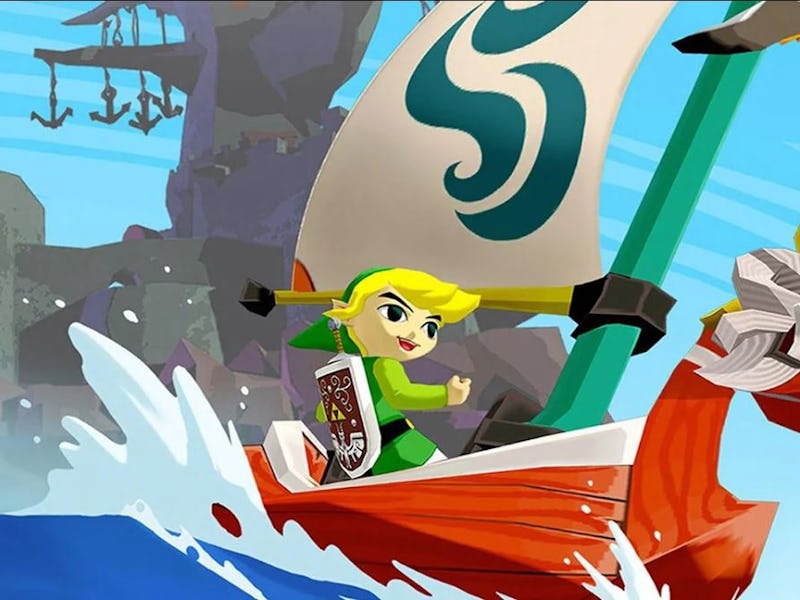20 Years Later, Wind Waker Is Still the Riskiest Zelda Game Ever Made
Tears of the Kingdom wouldn’t exist without the one that made Miyamoto cringe.

The brain hates change. When faced with unexpected change our amygdalas can fire up warning signals of fear, fight, or flight. It’s a useful survival mechanism left over from the days when we had bigger problems than Oscar snubs. It also helps explain why some fans go absolutely bonkers when their favorite franchise tries something new.
Such was the case 20 years ago, when Nintendo released its most controversial game in its storied action RPG franchise: The Legend of Zelda: Wind Waker on March 24, 2003.
In the Breath of the Wild era, it's hard to imagine a Zelda game being met with anything other than adulation. But gamers are a fickle bunch, especially in the early aughts when the target audience for games was shifting from kids to teens or teens to young adults. It was a very dudebro world with increasingly dark and serious games.
At Nintendo Space World 2000, the company’s then-annual showcase in Japan, it sure seemed like the series was headed in that direction for its GameCube debut.
But something unexpected happened. Eiji Aonuma, then-director of the franchise, thought a new console meant an opportunity to do something fresh. Something different. Instead of embracing the grimdark Zelda vibe, his team began exploring different styles. They coalesced around a cartoony style made possible by new technology: cel shading.
Cel shading wasn’t the norm in 2003. Gamers had a growing appetite for “realistic” games thanks to the increasingly sophisticated hardware that made 3D worlds possible. Aonuma and his team defied industry trends and fan expectations, and they ran afoul of legendary Nintendo producer Shigeru Miyamoto, too.
Hang in there, Toon Link. Your day will come.
Miyamoto, like most fans, anticipated a Zelda title that was a natural extension of the graphics and style of The Ocarina of Time and Majora’s Mask on Nintendo 64. Both titles were extremely well-received, and the more powerful GameCube would allow for the best-looking Zelda fans had ever seen. Aonuma knew this, and so he hid the controversial “toon Link” decision until development was already underway. Miyamoto said he “cringed” the first time he saw the game, and that the style would hurt sales. He was right.
Ever since Wind Waker debuted at Space World in 2001, there was a tremendous backlash online. This resentment tainted sales, which came in at under 5 million units sold. This was less than the lifetime sales for Majora’s Mask and a little more than half of the record set by Ocarina of Time. As the first Zelda title on a new console, expectations were closer to OoT. Aonuma’s experiment seemed to fail … or did it?
The press reception for Wind Waker was overwhelmingly positive, a bit of a surprise given how hard the media levied criticism in the wake of the Spaceworld demo. It boasts a 96 on Metacritic with several perfect scores from outlets like the venerable Japanese gaming weekly Famitsu. Critics came around on the art style, for many their first experience with cel shading. The once-maligned “Cel-da” proved that there was a place for playable cartoons alongside realism.
Wind Waker was also fun to play. At Miyamoto’s suggestion, the team lowered the difficulty of the game. He felt too many players had given up on the N64 titles due to their brutal boss fights. He wanted them to finish a story, not a game. This approach paired well with the easy breezy vibes brought on by the game’s art style and island setting. So despite its sales (or maybe because of them) Wind Waker gained an extra life when a reboot for the Wii U released in 2013.
Nintendo endorses piracy (sometimes).
Wind Waker HD has become the definitive version of the game. It addressed major flaws, particularly the original’s tedious sailing, and looked stunning in HD thanks to newer, better lighting systems on the Wii U. In the 10 years since the original’s release cel shading had gained popular acceptance. It turns out people did like it, and Aonuma was right all along.
The remake sold around 3 million copies worldwide and, crucially for Nintendo, caused a bump in sales for the struggling Wii U. It also paved the way for the next cel-shaded Zelda title, 2017’s Breath of the Wild and the upcoming Tears of the Kingdom set for release in May. BotW is the best-selling Zelda in history, but it owes a debt to Wind Waker and the bold experimentation from Aonuma and his team.
In a funny twist of fate, the Twilight Princess visuals now struggle in comparison to Wind Waker, especially in HD. Games that use cel shading have an easier time achieving a “timeless” look that doesn’t feel as dated over time. This is no doubt appealing for a franchise with the pedigree of The Legend of Zelda, and its potential for the kinds of anniversary remakes that fans would really like to see happen.
Plus, Wind Waker is former President Barack Obama’s favorite game:
The Legend of Zelda: Wind Waker is still only available on Wii U and GameCube. Sorry.
This article was originally published on